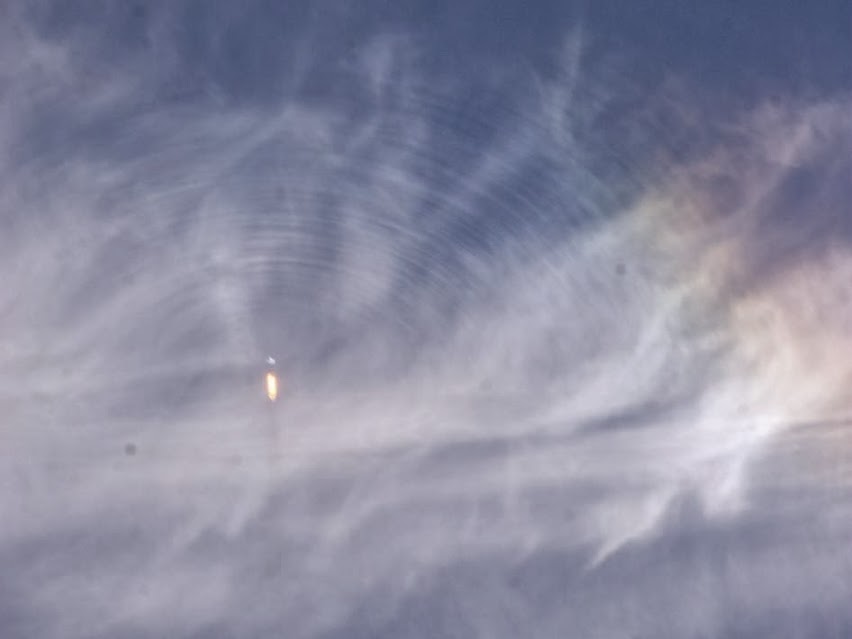
On this date in 2010 – the coolest space launch ever! I ran into this image and video via a post on Google+ and became interested when I saw a quote from the person who runs the world’s absolute best website for sky optics, Les Cowley of the website Atmospheric Optics. The story began with the 2010 launch of NASA’s Solar Dynamics Observatory (SDO), one of several observatories that keep an eye on our sun. It seems that when SDO lifted off from Cape Canaveral on February 11, 2010, on its mission to observe the sun, it first destroyed a sundog in Earth’s atmosphere – in the process bringing to light a new form of ice halo – and teaching those who love and study sky optics new things about how shock waves interact with clouds.
The video above shows SDO’s 2010 launch via an Atlas V rocket. Watch it now, and turn up the volume to hear people cheer when the spacecraft’s passage through the atmosphere destroyed the sundog – which is a bright spot in the sky, formed by refraction of sunlight through plate-shaped ice crystals, which drift down from the sky like leaves fluttering from trees. If you have to, watch it twice to see the luminous column of white light that appears next to the Atlas V.
Les Cowley explained in this 2011 post at Science@NASA:
When the rocket penetrated the cirrus, shock waves rippled through the cloud and destroyed the alignment of the ice crystals. This extinguished the sundog.
The sundog’s destruction was understood. The events that followed were not. Cowley said:
A luminous column of white light appeared next to the Atlas V and followed the rocket up into the sky. We’d never seen anything like it.
Cowley and colleague Robert Greenler at first couldn’t explain this column of light. Then they realized that the plate-shaped ice crystals were organized by the shock wave from the Atlas V. Cowley explained:
The crystals are tilted between 8 and 12 degrees. Then they gyrate so that the main crystal axis describes a conical motion. Toy tops and gyroscopes do it. The earth does it once every 26000 years. The motion is ordered and precise.
Love it!
Enjoying EarthSky so far? Sign up for our free daily newsletter today!

View larger. | When the Solar Dynamic Observatory (bright streak in lower right quadrant of photo) lifted off from Cape Canaveral on February 11, 2010, its launch enabled optics experts to discover a new form of ice halo. Image via NASA/Goddard/Anne Koslosky.
Bottom line: When NASA’s Solar Dynamics Observatory lifted off from Cape Canaveral on February 11, 2010, on its mission to observe the sun, it first destroyed a sundog in Earth’s atmosphere – in the process bringing to light a new form of ice halo – and teaching those who love and study sky optics new things about how shock waves interact with clouds.
Via Science@NASA and Les Cowley’s Atmospheric Optics
from EarthSky http://bit.ly/2RTU3Uj

On this date in 2010 – the coolest space launch ever! I ran into this image and video via a post on Google+ and became interested when I saw a quote from the person who runs the world’s absolute best website for sky optics, Les Cowley of the website Atmospheric Optics. The story began with the 2010 launch of NASA’s Solar Dynamics Observatory (SDO), one of several observatories that keep an eye on our sun. It seems that when SDO lifted off from Cape Canaveral on February 11, 2010, on its mission to observe the sun, it first destroyed a sundog in Earth’s atmosphere – in the process bringing to light a new form of ice halo – and teaching those who love and study sky optics new things about how shock waves interact with clouds.
The video above shows SDO’s 2010 launch via an Atlas V rocket. Watch it now, and turn up the volume to hear people cheer when the spacecraft’s passage through the atmosphere destroyed the sundog – which is a bright spot in the sky, formed by refraction of sunlight through plate-shaped ice crystals, which drift down from the sky like leaves fluttering from trees. If you have to, watch it twice to see the luminous column of white light that appears next to the Atlas V.
Les Cowley explained in this 2011 post at Science@NASA:
When the rocket penetrated the cirrus, shock waves rippled through the cloud and destroyed the alignment of the ice crystals. This extinguished the sundog.
The sundog’s destruction was understood. The events that followed were not. Cowley said:
A luminous column of white light appeared next to the Atlas V and followed the rocket up into the sky. We’d never seen anything like it.
Cowley and colleague Robert Greenler at first couldn’t explain this column of light. Then they realized that the plate-shaped ice crystals were organized by the shock wave from the Atlas V. Cowley explained:
The crystals are tilted between 8 and 12 degrees. Then they gyrate so that the main crystal axis describes a conical motion. Toy tops and gyroscopes do it. The earth does it once every 26000 years. The motion is ordered and precise.
Love it!
Enjoying EarthSky so far? Sign up for our free daily newsletter today!

View larger. | When the Solar Dynamic Observatory (bright streak in lower right quadrant of photo) lifted off from Cape Canaveral on February 11, 2010, its launch enabled optics experts to discover a new form of ice halo. Image via NASA/Goddard/Anne Koslosky.
Bottom line: When NASA’s Solar Dynamics Observatory lifted off from Cape Canaveral on February 11, 2010, on its mission to observe the sun, it first destroyed a sundog in Earth’s atmosphere – in the process bringing to light a new form of ice halo – and teaching those who love and study sky optics new things about how shock waves interact with clouds.
Via Science@NASA and Les Cowley’s Atmospheric Optics
from EarthSky http://bit.ly/2RTU3Uj

Aucun commentaire:
Enregistrer un commentaire